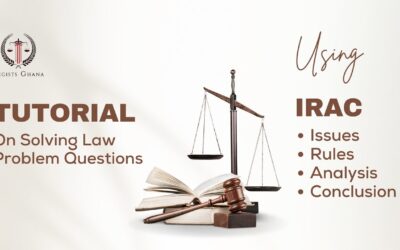
sethdoeesq@gmail.com
Law questions generally come in any of these three forms:
- Essay questions
- Problem questions
- Multiple choice questions
Law essay questions usually require you to express a legal opinion or address the law on a specific subject matter. The subject matter is usually referred to as the topic sentence.
The examinee can be instructed to Clarify, Analyze, Discuss, Evaluate, Write an Opinion, Explain and Illustrate the law concerning the subject matter (topic sentence/thesis statement).
A law problem question is usually a set of facts that is made available to the examinee to raise legal issues between identifiable parties in the question and address the issues by applying the relevant authorities. Addressing law problem questions is by the Issues, Rules, Analysis and Conclusion (IRAC) method.
Multiple-choice questions usually present answer options for the examinee to choose from. This means the examinee is restricted to the answer options and simply has to select the most appropriate answer from the provided choices.
This write-up seeks to express how to answer law essay questions and it only serves as a guide to law students.
Example of a law essay question.
“Parliament is vested with the legislative powers so in that sense it is supreme and yet not supreme. The question is not whether it has the power to make laws and exercise its functions, but whether the procedural means of exercising its power as required by the laws have been followed.” Discuss with reference to Supreme Court Decisions.
GENERAL FORMAT FOR LAW ESSAYS:
Law Essays are very similar to ordinary essays and include the basic structure of:
- Introduction
- Body
- Conclusion
The introduction is the first part of the law essay and it is the most important. The introduction provides the background to the legal topic at hand and guides the reader or the examiner to the forthcoming analysis that will be raised by the writer (examinee). The introduction articulates the topic sentence and serves to engage the reader with the preliminary statement. It outlines the key issues that will be addressed and sets the overall tone of the essay
The Introduction is divided into three parts.
- Preliminary statement to the topic sentence
- Topic sentence
- Means/approach to the analysis
The Preliminary statement to the topic sentence introduces the topic sentence or thesis statement to the examiner. Most students write an eye-catching and compelling statement that hooks the examiner or reader and keeps the examiner or reader engaged.
Instead of writing;
This essay seeks to express an opinion on parliamentary sovereignty and constitutionalism, state an eye-catching statement first and then lead the examiner to the topic sentence (subject matter of the essay).
How do you write a good leading or catching statement?
Read the question carefully to determine the topic sentence and write an intriguing statement about the topic sentence.
For a question that deals with legislative powers, you can start with a compelling sentence, either a fact or an intriguing statement that serves as the foundation for the topic sentence.
Topic sentence.
The topic sentence is the thesis statement of the point for analysis. It is the matter your legal analysis and opinion should address.
The approach briefly states how the topic sentence will be addressed.
BODY OF THE ESSAY
The main body of the essay expresses the central idea or the topic sentence in paragraphs. The purpose of the body is to develop your argument through analysis, critical evaluation, and legal authorities such as statutory provisions, precedent and many more.
The body of the essay is divided into numerous paragraphs. Each paragraph is a building block towards reaching a sound and coherent conclusion on the legal opinion.
Therefore the paragraphs must be organized and convey a relevant point or analysis.
The main body should have:
- Leading paragraphs expressing main legal opinions
- The supporting paragraphs that provide an evaluation or analysis of the lead opinions.
- The paragraphs that contain legal authorities and summaries of supporting laws and provisions.
- The paragraphs that reflect on opposing arguments and rebuttals to opposing arguments.
To avoid writing empty paragraphs, use this approach:
- The paragraph begins with an introduction to reflect the key point or central idea. The central idea must be linked to the topic sentence.
- The central idea is backed by relevant authorities such as statutory provisions, case law and legal principles. The legal principles must provide sound legal backing to the opinion you are presenting.
- Therefore it is recommended not to simply restate legal provisions or principles but explain how they support or back the legal opinion.
- Critically evaluate the law in relation to your issue.
- Each paragraph should be a solid block leading to another paragraph until the final conclusion. Use clear transitions between paragraphs to maintain flow and coherence in your argument. The paragraphs read in entirety must completely reflect your legal opinion.
- To avoid gaps in your legal argument, critically discuss counter arguments or opposing viewpoints. Present them fairly and provide rebuttals to strengthen your position.
References
In an exam hall, the student is not expected to write full citations of legal authorities but if it is an open book or take-home examination then the appropriate referencing style recommended by the examiner should be utilized.
Conclusion:
Writing a law essay involves a key understanding of the topic sentence with a structured approach to addressing or discussing the topic sentence, backing your opinion with a sound analysis of legal authorities. The writer must appreciate possible counter arguments and give credible rebuttals. By focusing on a clear introduction, well-supported body paragraphs, and a strong conclusion, while also considering legal research, clarity, and citation practices, the writer can effectively communicate coherent analytical thought creating a positive impression on the reader.





